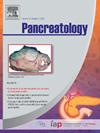切除的未经治疗的胰腺癌患者的肿瘤免疫微环境与长期生存。
IF 2.8
2区 医学
Q2 GASTROENTEROLOGY & HEPATOLOGY
引用次数: 0
摘要
背景:胰腺导管腺癌(PDAC)是全球致死率最高的癌症之一。目前,只有一小部分患者成功接受了最有效的治疗方法--手术切除。要改进治疗策略,就必须深入了解延长患者手术切除后生存期的因素:本研究旨在通过元转录组学和多重免疫荧光(IF)染色分析确定 PDAC 患者长期生存的重要因素。具体而言,研究了治疗无效的 PDAC 短期幸存者(STS,总生存期为 5 年)之间肿瘤免疫微环境(TIME)的差异:结果:在LTS中,我们检测到了589个高表达基因,包括HOXB9、CDA和HOXB8,以及507个低表达基因,包括AMY2B、SCARA5和SLC2A2。我们数据中富集的大多数 Reactome 过度生物学通路在 LTS 中过度表达,如 RHO GTPase Effectors 和 Cell Cycle Checkpoints。有 11 个微生物组在 LTS 和 STS 之间存在明显差异,包括 Sphingopyxis 和 Capnocytophaga。重要的是,我们证明了记忆B细胞丰度增加、M0和亲肿瘤M2巨噬细胞减少的TIME特征与PDAC的良好预后相关:在这项研究中,我们通过元转录组学和IF染色分析深入研究了TIME,以了解延长PDAC患者生存期的先决条件。在LTS中,有几种生物通路被过度表达,并发现了特定的微生物组。此外,还发现了驱动免疫因子的明显差异,这为制定新的治疗策略提供了宝贵的见解。本文章由计算机程序翻译,如有差异,请以英文原文为准。
The tumor immune microenvironment in resected treatment-naive pancreatic cancer patients with long-term survival
Background
Pancreatic ductal adenocarcinoma (PDAC) is one of the most lethal cancers worldwide. Presently, only a fraction of patients undergo successful surgical resection, the most effective treatment. Enhancing treatment strategies necessitates a deep comprehension of the factors underlying extended survival after surgical resection in patients.
Methods
This study aims to identify the important factors of PDAC patients’ long-term survival with metatranscriptomics and multiplex immunofluorescence (IF) staining analyses. Specifically, differences in tumor immune microenvironment (TIME) were investigated between treatment-naïve PDAC short-term survivors (STS, overall survival <6 months) and long-term survivors (LTS, overall survival >5 years).
Results
As a result, we detected 589 over-expressed genes, including HOXB9, CDA, and HOXB8, and 507 under-expressed genes, including AMY2B, SCARA5, and SLC2A2 in LTS. Most of the Reactome overbiological pathways enriched in our data were over-expressed in LTS, such as RHO GTPase Effectors and Cell Cycle Checkpoints. Eleven microbiomes significantly differed between LTS and STS, including Sphingopyxis and Capnocytophaga. Importantly, we demonstrate that the TIME profile with an increased abundance of memory B cells and the reduction of M0 and pro-tumoral M2 macrophages are associated with a good prognosis in PDAC.
Conclusions
In this study, we delved into the TIME with metatranscriptomics and IF staining analyses to understand the prerequisite of prolonged survival in PDAC patients. In LTS, several biological pathways were overexpressed, and specific microbiomes were identified. Furthermore, apparent differences in driven immune factors were found that provide valuable insights into developing new treatment strategies.
求助全文
通过发布文献求助,成功后即可免费获取论文全文。
去求助
来源期刊

Pancreatology
医学-胃肠肝病学
CiteScore
7.20
自引率
5.60%
发文量
194
审稿时长
44 days
期刊介绍:
Pancreatology is the official journal of the International Association of Pancreatology (IAP), the European Pancreatic Club (EPC) and several national societies and study groups around the world. Dedicated to the understanding and treatment of exocrine as well as endocrine pancreatic disease, this multidisciplinary periodical publishes original basic, translational and clinical pancreatic research from a range of fields including gastroenterology, oncology, surgery, pharmacology, cellular and molecular biology as well as endocrinology, immunology and epidemiology. Readers can expect to gain new insights into pancreatic physiology and into the pathogenesis, diagnosis, therapeutic approaches and prognosis of pancreatic diseases. The journal features original articles, case reports, consensus guidelines and topical, cutting edge reviews, thus representing a source of valuable, novel information for clinical and basic researchers alike.
 求助内容:
求助内容: 应助结果提醒方式:
应助结果提醒方式:


